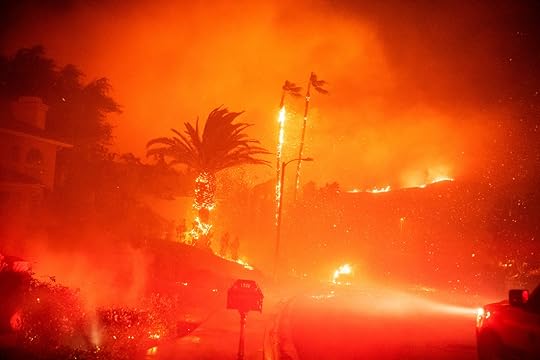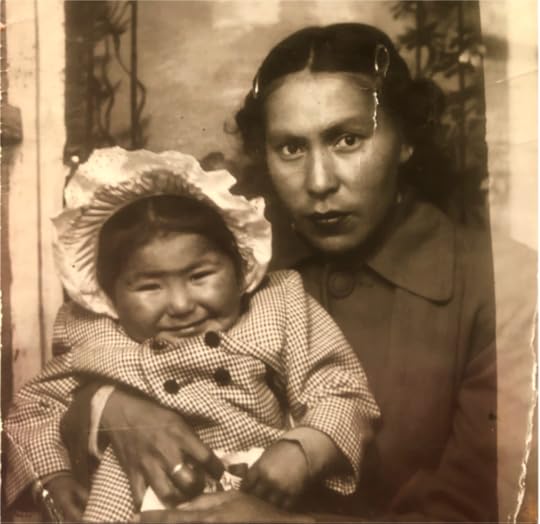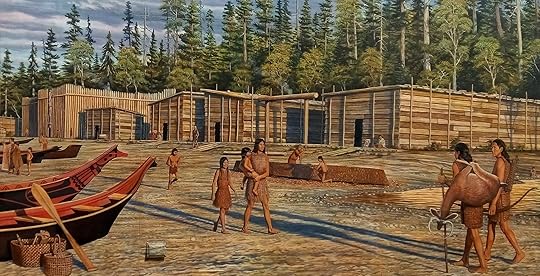Stewart Brand's Blog, page 22
May 15, 2019
Former Seminar Speaker Stephen Pyne Interviewed in Piece About California Wildfires

Former Seminar speaker Stephen Pyne was recently interviewed for a piece in New York Magazine about what it means to build permanent structures in California—a state that was always meant to continually burn and shake.
So quickly, according to the fire historian Stephen Pyne, we forget the threat is even real. “We think that cities don’t burn — maybe the fringe will lose a house or two, or maybe a strip, but actually propagating through a city is something that doesn’t happen anymore,” Pyne says. “But it does. It’s like watching an old plague — or measles. You know, ‘Hey, we don’t have measles anymore; we don’t need to vaccinate.’ ”
Pyne calls himself “a pyromantic — not a pyromaniac, important distinction. I take a fire-centric or pyro-centric view of things.” For him, the story of the planet and of human civilization is one of fire, which makes climate change one as well — a matter ultimately of what we’ve chosen to pull out of the Earth and burn. But trees are fossil fuels, too, in their way; they store carbon, and, like coal, when burned, release it — which may be enough each year via wildfire to wipe out all of the emissions gains achieved in the state through green policy.
Pyne’s prescription for Southern California is ten times more fire, though of the controlled-burn variety. Without that, and with continued wildland development, “we’re going to have horrific fires, and we’re going to have a lot more of them,” he says. “What is the cause of all this? What are the drivers, as people like to say? I would respond to that by saying I think a fire is a driverless car: It’s barreling down the road; it’s integrating everything around it. The prevailing narrative is one of dumb Westerners building houses where there are fires, but I think what we’re seeing — and this is a combination of land use, climate change, and other factors — is that the fires are going where the houses are.”
Via New York Magazine.

May 13, 2019
Translating the Big Bang into Blackfoot

Meet Corey Gray and Sharon Yellowfly, a mother-son duo translating astrophysics into the Native American language Siksika (Blackfoot).
On April 1, scientists will officially restart their search for gravitational waves after a year spent making improvements to massive twin detectors. Discoveries should soon start rolling in, and when they do, there’s a good chance the news will be translated into a Native American language called Blackfoot, or Siksika.
That’s thanks to Corey Gray, who works at the Laser Interferometer Gravitational-Wave Observatory (LIGO) site in Washington state. He has been collaborating with his mom to translate this cutting-edge field of science into an endangered languagespoken by just thousands of people worldwide.
Via NPR.

May 10, 2019
Laura Welcher speaks at Rhizome 7 x 7

Last month, Long Now’s Laura Welcher was part of the group of artists and technologists that were invited to Rhizome’s Seven on Seven conference in New York City. Welcher and artist Hayal Pozanti presented their art project WantNot. From Art News:
“Fate brought us together,” Laura Welcher, the director of operations at the Long Now Foundation, said admiringly of her partner that day, the artist Hayal Pozanti. United by a shared interest in linguistics, the two self-classified “language nerds” presented a new work—WantNot, a glyph of sorts intended to communicate mutual respect to future humans (or aliens) who might come upon it. They 3D-printed their curious object, which resembles an abstract bird with its head bent, using terracotta, a biodegradable substance. And they shared the news that anyone who wanted to could do the same, thanks to a website they built. “We encourage the idea of not getting too attached to wanting WantNot,” Pozanti said.
Read the Art News writeup in full here.

May 9, 2019
Ancient Native Legend About a Great Flood is True, Study Finds

Geologists have verified that the legend of a great flood passed down orally by the Pacific Northwest’s Klallam people for 2,700 years is not a myth, but a warning. A new study has found that as many as five tsunamis hit an ancient Klallam village in present-day Washington state.
The evidence comes from an archaeological dig of the major village at the base of Ediz Hook that was inhabitated for most of the past 2,700 years. After each earthquake and tsunami disaster, the village people rebuilt and rebounded. A Portland State anthropologist said the story of Tse-whit-zen (pronounced ch-WHEET-son) village underscores that if people are prepared, they can survive the feared Big One.
Via Northwest Public Broadcasting.

May 8, 2019
Trevor Paglen’s Orbital Reflector Goes “Unrealized”

On December 3rd, 02018, Trevor Paglen’s Orbital Reflector launched into low orbit as part of the payload on SpaceX’s Falcon 9 rocket. The 100-foot-long diamond shaped mylar balloon was intended to be the world’s first space sculpture. It would be visible to the naked eye, appearing as a slowly-moving star in the sky. Paglen saw the project as a “catalyst” for asking what it means to be on this planet.
Unfortunately, Paglen’s vision won’t come to pass. Last week, the Nevada Museum of Art (co-producer of the project) confirmed that Orbital Reflector is “now officially being recognized as an unrealized artwork”:
Two unanticipated events occurred: 1) Due to the unprecedented number of satellites on the rocket, the U.S. Air Force was unable to distinguish between them and could not assign tracking numbers to many of them. Without a tracking number to verify location and position, the FCC could not give approval for inflation; and 2) The FCC was unavailable to move forward quickly due to the U.S. government shutdown.
Paglen also views Orbital Reflector’s demise as an unintended consequence of the U.S. government shutdown President Donald J. Trump initiated to secure funding for building a border wall with Mexico.
“I blame it completely on the government shutdown,” the artist said. “In order to deploy the balloon, you have to coordinate with the FCC, the military and NASA, but the FCC and the part of the military we need to deal with were both shut down so there was literally nobody we could call to get the approval for deployment.”
At 35 days, the government shutdown was the longest in United States history. By the time the FCC was back up and running, the satellite communication functions that would initiate the inflation and deployment of the Orbital Reflector balloon stopped working. The satellite was built to last for the expected interval of receiving FCC approval, but was never intended to withstand over a month in the heat of the sun in space.
Despite the failure to deploy, Paglen wrote in a Medium post that he nonetheless considered the Orbital Reflector project as a success for provoking conversation:
If the project’s goal was to provoke a conversation about the politics of space, it has been nothing less than a stellar success. And the story of OR has become an embodiment of those politics: the Trump administration’s insistence on building a wall between the United States and Mexico led to the demise of a spacecraft whose purpose was to questions these very kinds of politics.
He also believes that there’s still a possibility that Orbital Reflector will one day be realized:
I don’t know whether OR will ever deploy and inflate its reflective structure. It might, it might not. Ironically perhaps, the best chance of Orbital Reflector’s reflector deploying may come from a second system failure. If the spacecraft further degrades, any number of damaged components might inadvertently trigger the inflation sequence without warning. With this being the state of affairs, I think of Orbital Reflector’s current state as being in a state of unknown possibility, like an unopened present circling through the night sky. And I, for one, will keep my eyes on the stars, knowing that at any moment, a new one might spring to life.
Learn More:
Learn more about the project on The Nevada Museum of Art’s Orbital Reflector page.
Read Paglen’s update on the Orbital Reflector project.
Read The Nevada Museum of Art’s press release on Orbital Reflector’s challenges.

May 3, 2019
New Podcast: Siberia Salon
In our opening Conversation at The Interval for 02019, Stewart Brand, Kevin Kelly and Executive Director Alexander Rose discuss a 02018 research trip that witnessed the ongoing restoration of a part of Siberia back to its Pleistocene-era ecosystem. The team brought back DNA samples to evaluate for mammoth de-extinction, and lots of photos, video, and stories of a place where climate change and arctic deep time can be witnessed at once.
Listen here.

April 30, 2019
Jeff Goodell: We’re Not Going to ‘Fix’ Climate Change
There’s not going to be a ‘fix’ for climate change, says science journalist Jeff Goodell. There will only be adaptations. From the Long Now Seminar, “The Water Will Come.”

‘Extraordinary’ 500-Year-Old Library Catalog Reveals Books Lost to Time
Researchers in Copenhagen have discovered a catalog containing thousands of summaries of books from 500 years ago, many of which no longer exist:
The Libro de los Epítomes manuscript, which is more than a foot thick, contains more than 2,000 pages and summaries from the library of Hernando Colón, the illegitimate son of Christopher Columbus who made it his life’s work to create the biggest library the world had ever known in the early part of the 16th century. Running to around 15,000 volumes, the library was put together during Colón’s extensive travels. Today, only around a quarter of the books in the collection survive and have been housed in Seville Cathedral since 1552.
Via The Guardian.

April 24, 2019
Edge’s John Brockman Interviews Alexander Rose
Executive Director Alexander Rose recently sat down with John Brockman of Edge.org to discuss Long Now. (Brockman recently gave a talk at Long Now in February about A.I.).
There are almost no artifacts that have been built for very long periods of time. With things like the pyramids or Stonehenge—we knew the pyramids were for tombs, and we don’t know what Stonehenge was for, but we don’t feel as though we’re looking back in time and thinking that those generations cared about us. That’s the fundamental message we’re trying to achieve with the clock. It’s meant to be a message of hope about the present that we are going to continue to solve problems and have a good way of life as we move forward. Also, if we were to have burrowed into this mountain and found the clock already ticking, what clock do we wish we had found and what intent do we wish that those people had for us? To me, I wish that I would find something that made me feel as though past generations cared about me.
Read the interview in full here.

How to Create an Institution That Lasts 10,000 Years
Executive Director Alexander Rose recently sat down with John Brockman of Edge.org to discuss Long Now. (Brockman recently gave a talk at Long Now in February about A.I.).
There are almost no artifacts that have been built for very long periods of time. With things like the pyramids or Stonehenge—we knew the pyramids were for tombs, and we don’t know what Stonehenge was for, but we don’t feel as though we’re looking back in time and thinking that those generations cared about us. That’s the fundamental message we’re trying to achieve with the clock. It’s meant to be a message of hope about the present that we are going to continue to solve problems and have a good way of life as we move forward. Also, if we were to have burrowed into this mountain and found the clock already ticking, what clock do we wish we had found and what intent do we wish that those people had for us? To me, I wish that I would find something that made me feel as though past generations cared about me.
Read the interview in full here.

Stewart Brand's Blog
- Stewart Brand's profile
- 291 followers






